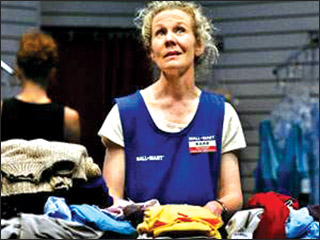The new poor
After training, still scrambling for employment:
Peter S. Goodman
In what was beginning to feel like a previous life, Israel Valle had
earned $18 an hour as an executive assistant to a designer at a
prominent fashion label. Now, he was jobless and struggling to find
work. He decided to invest in upgrading his skills.
The New Poor
It was February 2009, and the city work force center in Downtown
Brooklyn was jammed with hundreds of people hungry for paychecks. His
caseworker urged him to take advantage of classes financed by the
federal government, which had increased money for job training. Upgrade
your skills, she counseled. Then she could arrange job interviews.
|

Training to get to a higher position |
For six weeks, Valle, 49, absorbed instruction in spreadsheets and
word processing. He tinkered with his resume. But the interviews his
caseworker eventually arranged were for low-wage jobs, and they were
mobbed by desperate applicants. More than a year later, Valle remains
among the record 6.8 million Americans who have been officially jobless
for six months or longer. He recently applied for welfare benefits.
“Training was fruitless,” he said. “I’m not seeing the benefits.
Training for what? No one’s hiring.”
Hundreds of thousands of Americans have enrolled in federally
financed training programs in recent years, only to remain out of work.
That has intensified skepticism about training as a cure for
unemployment.
Even before the recession created the bleakest job market in more
than a quarter-century, job training was already producing disappointing
results. A study conducted for the Labour Department tracking the
experience of 160,000 laid-off workers in 12 states from mid-2003 to
mid-2005 -a time of economic expansion, found that those who went
through training wound up earning little more than those who did not,
even three and four years later.
“Over all, it appears possible that ultimate gains from participation
are small or nonexistent,” the study concluded. In the last 18 months,
the Obama administration has embraced more promising approaches to
training focused on faster-growing areas like renewable energy and
health care. But most money has been directed at the same sorts of
programs that in past years have largely failed to steer laid-off
workers toward new careers, say experts, and now the number of job
openings is vastly outnumbered by people out of work. “It’s such an ugly
situation that job training can’t solve it,” said Ross Eisenbrey, a job
training expert at the Economic Policy Institute, a labour-oriented
research institution in Washington, and a former commissioner of the
federal Occupational Safety and Health Review Commission.
“When you have five people unemployed for every vacancy, you can
train all the people you want and unfortunately only one-fifth of the
people will get hired. Training doesn’t create jobs.”
Labour economists and work force development experts say the
frustration that frequently results from job training reflects the
dubious quality of many programs. Most last only a few months, providing
general skills without conferring useful credentials in specialized
fields.
Programs rarely involve potential employers and are typically too
modest to enable cast-off workers to begin new careers. Most job
training is financed through the federal Workforce Investment Act, which
was written in 1998 - a time when hiring was extraordinarily robust.
Then, simply teaching jobless people how to use computers and write
resumes put them on a path to paychecks. Today, even highly skilled
people with job experience of two decades or more languish among the
unemployed. Whole industries are being scaled down by automation, the
shifting of work overseas and the recession.
|

In Minnesota, David Gustafson was trained to program machinery:
Just as soon as I could say, “Yes, I can program,” I got a job.” |
“A lot of the training programs that we have in this country were
designed for a kind of quick turnaround economy, as opposed to the
entrenched structural challenges of today,” said Carl E. Van Horn, a
labour economist and director of the John J. Heldrich Center for
Workforce Development at Rutgers University.
“It’s like attacking a mountain with a toothpick. You take a policy
that was designed for the best economy that we had since World War II
and you lay it up against the economy that is the worst since World War
II. It can’t work.”
Claiming successes
The Obama administration argues that expanded job training has
already delivered success. As part of the nearly $800 billion stimulus
package begun last year, the administration increased grants sent to
states for training programs devoted to laid-off workers by $1.4 billion
for 2009 and 2010.
Those funds came on top of $2.9 billion allocated through normal
budget channels for grants in those two years. Last year, the number of
laid-off workers in job training reached 241,000, up from about 124,000
the year before, according to the Labour Department.
“These programs are really working,” said the assistant secretary of
labour, Jane Oates. “These are folks who clearly want to go back to work
and we’re able to help them get back to work. The investment in job
training is one that’s not only going to pay off in the short term, it’s
going to help us be more competitive in the long term.”
According to the Labour Department, 85 percent of laid-off workers
who received training in 2007 and 2008 gained jobs within a year of
completion. But the department does not track what percentage of them
gained jobs in their fields of study and so far lacks any data for 2009,
the first year of the Obama administration’s expansion.
In Minnesota, David Gustafson was trained to program machinery: “Just
as soon as I could say, ‘Yes, I can program,’ I got a job.”
Articles in this series are examining the struggle to recover from
the widespread strains of the Great Recession. Experts harbor doubts
about the reliability of Labour Department numbers, which are derived
from reports by state agencies that collect data from community colleges
and employment offices whose training funds are dependent upon reaching
benchmarks.
Twice the Labour Department had to correct the data it supplied for
this article. “The states play all sorts of games,” said Eisenbrey, from
the Economic Policy Institute.
Signs of Progress
But those who oversee job training say results have improved
significantly in recent years. “We’ve come a long way,” said Robert W.
Walsh, commissioner of the New York City Department of Small Business
Services, which oversees the Workforce1 career centers, including the
Brooklyn office where Valle enrolled. “We’re now focused on where the
jobs are and the track records of the providers.”
Those factors are crucial, say advocates for expanded training, who
point out that even with near double-digit unemployment, some jobs lie
vacant, awaiting workers with adequate skills.
“There’s plenty of jobs in health care, in technology,” said Fred
Dedrick, executive director of the National Fund for Workforce
Solutions, which advocates for increased and improved job training.
“Once people move up, that creates opportunities for other workers.”
There is some evidence that this approach works. Two years after
completing programs tied directly to the needs of local industries
suffering shortages of skilled workers in the South Bronx, Boston and
Milwaukee, graduates were earning 29 percent more than similar workers
who did not receive training, according to a new survey from
Public/Private Ventures, a nonprofit group that advocates for expanded
job training.
A widely admired program begun in Michigan in 2007, No Worker Left
Behind, provides up to $10,000 over two years for laid-off and
underemployed workers who pursue certificates and degrees in areas of
significant growth. The program has trained technicians to work on major
energy storage projects and aircraft mechanics to service engines at
commercial operations that have taken over former Air Force bases.
“We need to know that we’re training people in an in-demand growth
area today,” said Andrew S. Levin, who oversees the Michigan program.
But forecasting where jobs will be can be tricky. Among those completing
training by the end of 2009, 41 percent were still looking for work as
of June, according to Michigan data.
Nationally, prospective trainees are often steered into programs by
counselors at community colleges and employment centers who lack
awareness about which industries are hiring.
In the suburbs of Philadelphia, Eric Nelson left a job at a credit
union call center in late 2004 to enroll at a state college. There, the
career services department helped him choose a course of study by
consulting job growth projections. The result led to geographic
information systems -the mapping of data by place.
“It seemed like the thing to do,” Nelson recalled, adding that he was
assured he would easily land an entry-level job paying $35,000 a year.
But when Nelson, 42, graduated with his bachelor’s degree in May 2008,
facing nearly $50,000 in student loan debt, he was horrified to discover
that graduates greatly outnumbered jobs. Only people with six or seven
years’ experience were getting hired, he said.
“I’ve had no offers at all,” he said. He is now living off his wife’s
wages as a librarian and contributions from his parents. Even programs
with successful track records tend to be focused on people who are
easier to employ - those with substantial skills and experience. In late
2007, in the Minneapolis suburbs, Hennepin Technical College joined with
local employers to help workers laid off from area factories secure new
jobs.
More skills, better luck
The Minneapolis-St. Paul area exemplifies how unemployment reflects
not only a shortage of jobs but also a mismatch between jobs and skills.
A half-century ago, mainframe computers were assembled in the area,
before the business shifted to Silicon Valley. But large-scale
manufacturing remains, particularly in one fast-growing industry whose
jobs seem unlikely to be shifted overseas: medical devices.
The New York Times |



